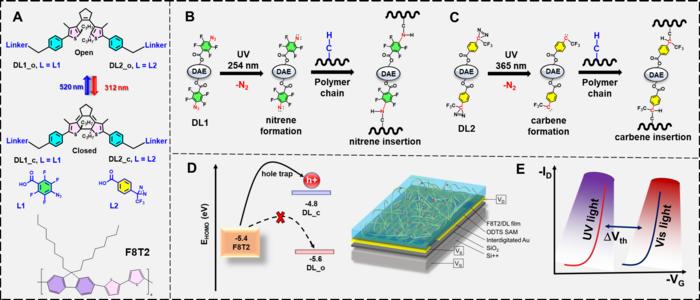In the tale of the herdsman and the weaver, “Ojak Bridge” stood as a testament to the enduring love between them, crafted by the crow and the magpie. Similarly, in the realm of chemical engineering, functional molecules forge bonds much like the avian duo once did.

Credit: POSTECH
In the tale of the herdsman and the weaver, “Ojak Bridge” stood as a testament to the enduring love between them, crafted by the crow and the magpie. Similarly, in the realm of chemical engineering, functional molecules forge bonds much like the avian duo once did.
A research team led by Professor Dae Sung Chung and Dr. Syed Zahid Hassan from the Department of Chemical Engineering at Pohang University of Science and Technology (POSTECH) has developed a memory transistor capable of adjusting its threshold voltage. This innovation combines two molecules that form a stable bond with a polymeric semiconductor, situated at the end of a molecular switch. The research recently featured in the online edition of “Advanced Science,” an international materials science journal.
These molecular switches control electrical signals by leveraging the conversion properties of diverse organic molecular isomers. When integrated into field-effect transistors (FETs), they govern electron flow at the molecular scale. While molecular switch-based FETs have been a key technology for implementing organic FETs (OFETs) in recent years, their longevity has been hampered by the limited ability of the molecules that act as switch molecules to serve as efficient deep traps for capturing and storing electrons within the semiconductor layer.
In this research, the team tackled this challenge by constructing a bridge illuminated by “light.” They pioneered a novel method to establish a “photonic bridge,” a light-triggered chemical linkage between a molecular switch molecule and a polymeric organic semiconductor. At the terminus of the molecular switch, consisting of diarylethene (DAE), the team combined an azide and a diazirine. Under light exposure, these two functional groups forge a chemical connection with the organic polymer semiconductor, stabilizing the typically precarious closed isomer of DAE in a deep-trapped state.
In experimental trials, the OFETs incorporating the team’s DAE compounds demonstrated remarkable endurance, maintaining stable deep-trap states for durations exceeding a million seconds. Furthermore, they showcased exceptional photoprogrammable on-off switching ratios surpassing 1,000 at a voltage of 22 V, alongside outstanding storage performance, enduring stability through more than 100 cycles.
Specifically, the team’s OFETs boast precise patterning through photocrosslinking, enabling meticulous control of the semiconductor layer’s structure. The researchers identified diverse applications for their findings, spanning microelectronics and optoelectronics.
Professor Dae Sung Chung of POSTECH expressed his expectation by saying, “This research unveils fresh prospects in memory transistor realms, impacting data storage and processing technologies profoundly. It holds promise for innovation across a spectrum of disciplines, extending beyond the domain of transistors.”
The research was conducted with support from the BK21 Innovative Chemical Engineering Leadership Program of the National Research Foundation of Korea and a program of Toray Advanced Materials Korea.
Journal
Advanced Science
DOI
10.1002/advs.202401482
Article Title
Photophore-Anchored Molecular Switch for High-Performance Nonvolatile Organic Memory Transistor
Article Publication Date
30-Mar-2024




